I’m working on a follow-up to “Have To” History: Landmark Supreme Court Cases. I haven’t settled on a title yet, but the content seems to revolve around cases involving church-state separation in relation to public schools – and there are a LOT of them. I’m posting first drafts as I go, partly to share with you, my Eleven Faithful Followers, and partly because nothing brings out the typos, grammar errors, and other shortcomings like publishing something online.
“Normally I’d Agree With You, But Come On… It’s the AMISH!”
Background
Orthodox Amish and your more conservative Mennonites are a fairly traditional bunch. While popular culture tends to oversimplify their beliefs and caricaturize their lifestyles, it’s fair to say that in general they prefer to avoid excessive entanglement with the modern world. The Amish tend to be a bit more separatist overall, preferring to remain in their own communities and interact with the world as little as possible. Contemporary Mennonites, on the other hand, can be difficult to spot until you notice the social justice bumper sticker on their hybrid parked tranquilly in the church lot.
Even these are overgeneralizations, however. Both faiths encompass a wide range of approaches to appearance, behavior, technology, and interactions with outsiders. What’s fairly consistent across the spectrum is a prioritization of family and community over wealth, convenience, or individual accomplishment, and of course a particularly devout commitment to their Christian faith. From these ideals stem all the rest – the horses and buggies, the dashing hats and svelte black coats, the aversion to technology, and that wacky love of hard work and simple living.
In short, it’s not about whether electricity or shopping at Target is “evil;” it’s about what best serves the spirit over the flesh and the community over the individual. As it turns out, that was the issue in the early 1970s when Jonas Yoder and Wallace Miller, both Old Order Amish, and Adin Yutzy, a Conservative Amish Mennonite, pulled their children out of public school in Wisconsin after they’d successfully completed the 8th grade. They argued that while a basic education was fine – maybe even necessary – high school itself was too full of behaviors, ideologies, and subject matter which brazenly violated their religious beliefs and priorities. Rather than expect the school system to change to accommodate their faith (that wouldn’t be a very Amish approach), they simply removed their children from the system.
It’s not like the Amish or Conservative Mennonites let their kids lay around in their underwear eating Doritos and playing video games all day. Teenagers were expected to help care for animals, raise crops, cook and sew, or otherwise labor their little hearts out while learning essential skills for a long, healthy life in their respective communities. It seems unlikely their counterparts at the local high school were keeping a similar pace.
Amish You So Much
Wisconsin law required that kids be in school SOMEWHERE – public or private was up to the parents – until they were at least 16. Yoder, Miller, and Yutzy were prosecuted for violating state law and the case went to trial with Jonas Yoder acting on behalf of the group. While he was no doubt a capable individual, the Amish and Conservative Mennonites aren’t big on using the court system to resolve their difficulties. They do not, by and large, sue people for damages or seek legal recourse for minor infractions. An “Amish Lawyer” would be about as common as a “Shiite Stripper” or a “Hindu Butcher.”
The original court, in an effort to remain consistent with existing Supreme Court jurisprudence, determined that the requirement that parents keep their kids in school until the age of 16 was a valid secular state function. While there was no doubt that the Amish and Mennonites had genuine religious objections (they weren’t using religion as a pragmatic excuse for illegal behavior), that didn’t override the larger needs of the state as a whole. The families were convicted of violating Wisconsin law regarding mandatory school attendance, and each fined $5.00.
$5.00, as it happens, was the minimum penalty allowed by the statute in question. It doesn’t seem like too much of a leap to infer that while the court was willing to adhere to the letter of the law, they perhaps lacked the passion to make an example of these bearded rebels.
It was at this point that a Lutheran minister by the name of William C. Lindholm came on board. While he may not have shared the defendants’ precise theology, he supported their claims to religious freedom. The case was appealed to the Wisconsin Circuit Court, which affirmed the lower court’s decision, then to the State Supreme Court, which reversed it on the grounds that Wisconsin hadn’t actually demonstrated that there was anything about going to high school which was SO essential to the public good that it justified overriding the “free exercise” of the families involved.
It was now the State of Wisconsin’s turn to appeal (which is why their name is first in the title), and the case reached the Supreme Court.
The Decision
The Court, in a sort-of-unanimous decision, supported the Amish. Chief Justice Warren Burger wrote the Majority Opinion. Two Justices (Lewis F. Powell Jr. and William H. Rehnquist) abstained, as they’d joined the Court after the case had been heard. Justice Stewart wrote a very brief (and odd) concurrence, in which he was joined by Justice Brennan. Justice White added a longer (and slightly less odd) concurrence, in which he was joined by both Brennan AND Stewart. And Justice Douglas filed a dissent, in which he was joined by no one, and in which he supported the Court’s majority decision.
For such a landmark case, this one was a bit of a mess. Imagine if it HADN’T been unanimous…
Chief Justice Burger’s Majority Opinion took a three-step approach to explaining the Court’s rationale. First, he addressed the question of whether the beliefs in question were legit (as opposed to being conjured up pragmatically to justify illegal behavior or otherwise falling outside commonly accepted definitions of “religion”). After sharing a history lesson on the Amish, Burger determined that they and their spin-offs were all widely-recognized and well-respected forms of traditional American Christianity.
Since this had never actually been challenged, it’s worth asking why Burger would devote so much energy to “establishing” the validity of the Amish and their ilk as religious communities. The most obvious explanation is the Court’s constant awareness that everything they say and do becomes precedent for every other court, both present and future, at every level across the nation. Thus, a degree of respectful delineation is often appropriate. One can’t help but suspect, however, that there’s a secondary motivation for Burger’s cautious venture into historical apologetics. He was in many ways laying the groundwork for the Court’s almost paradoxical decision: “Look, we agree with the State in theory – in most circumstances they’d be correct and we don’t want anyone else to get carried away and think they can do whatever they want in the name of religion. But, dude… this is the AMISH.”
He put it a bit more jurisprudentially than that.
Step two was to examine whether or not the law in question created a substantial burden for the beliefs validated in step one:
The impact of the compulsory attendance law on respondents’ practice of the Amish religion is not only severe, but inescapable, for the Wisconsin law affirmatively compels them, under threat of criminal sanction, to perform acts undeniably at odds with fundamental tenets of their religious beliefs… It carries with it precisely the kind of objective danger to the free exercise of religion that the First Amendment was designed to prevent…
{T}he unchallenged testimony of acknowledged experts in education and religious history, almost 300 years of consistent practice, and strong evidence of a sustained faith pervading and regulating respondents’ entire mode of life support the claim that enforcement of the State’s requirement of compulsory formal education after the eighth grade would gravely endanger, if not destroy, the free exercise of respondents’ religious beliefs.
So that would be a “yes.”
Finally, the Court asked whether or not the state’s interest in pushing public education beyond 8th grade was substantial enough to justify overriding the rights of Amish parents to keep their kids home doing other things. At that point, there was no way to avoid substantial subjectivity, despite the Court’s effort to frame their response in terms of precedential cases and constitutional reasoning. Despite the substance of their decision, they seemed uncomfortable straying too far from the “belief-action” distinction established in Reynolds v. United States (1879).
Beliefs v. Actions (Place Your Bets)
Reynolds was a polygamy case. Mormons insisted the practice was part of their “free exercise” of religion. It didn’t hurt anyone and involved only consenting adults. Dominant American culture countered with “Eeewww! Weird!” and the courts were included to agree. Given that “Gross!” was a rather weak constitutional argument, they instead proffered the “belief-action” theory – you can BELIEVE whatever you like, thanks to the First Amendment, but the law can still set limits on what you can DO. In other words, freedom of religion is not absolute. The State has a right and an obligation to pass rules that help hold society together, which includes not letting people just go and marry whoever they want as many times as they want and then go about their business like it wasn’t totally “OMGWHAT?!”
Again, they put it a bit more formally.
Strictly construed, this same reasoning would prescribe that while the Amish and their ilk were welcome to BELIEVE whatever they liked about public schooling and the values of the modern world destroying their youth, that didn’t mean they could ACT on it without consequences. The Court wasn’t quite ready to go there, however, instead choosing to remind us a half-dozen more times what nifty folks the Amish were and how well they seemed to get along without telephones or nuclear power or public assistance. All the usual reasons given for why kids needed to stay in school – to get good jobs, to become informed voters, to grow into productive members of society – the Amish already had covered quite convincingly.
The Court had already been quietly pulling back from this “belief-action” ideology, despite paying it clarified respects in Wisconsin and then becoming infatuated with it again in subsequent cases. Major decisions were finding more and more instances in which sincerely held religious beliefs were enough to offset otherwise valid laws or policies. (In the most famous of these, Sherbert v. Verner (1963), the Court required the State of South Carolina to pay unemployment to a Seventh Day Adventist who was fired for refusing to work on Saturdays, despite specifically guaranteeing protection for those who might object to working on Sundays. The burden thus imposed on Seventh Day Adventists exclusively violated their right to “free exercise” of their faith.)
Aftermath
The ultimate import of Wisconsin v. Yoder was – and is – to some extent “in the eye of the beholder.” It’s easily read as strengthening parental rights over their children’s education, a principle established in prior cases but without the overtly religious motivation seen here. It was certainly a major victory for the Amish and their ilk, but to what extent similar exemptions would apply to other religious groups was uncertain.
On the other hand, the Court’s written opinion certainly suggested that one of the primary reasons the Amish didn’t have to obey this particular law was because their theology, lifestyle, and work ethic fit closely enough with the larger ideals of traditional American culture without directly participating in the modern version more than necessary. If a primary purpose of Supreme Court jurisprudence is to offer guidance and consistency going forward, a decision built around the exception to several already uncertain “rules” wasn’t exactly ideal.
RELATED POST: “Have To” History: A Wall of Separation
RELATED POST: A Wall of Separation: Lemon v. Kurtzman (1971) and the “Lemon Test”
RELATED POST: The Jehovah’s Witnesses Flag Cases (Part Two)

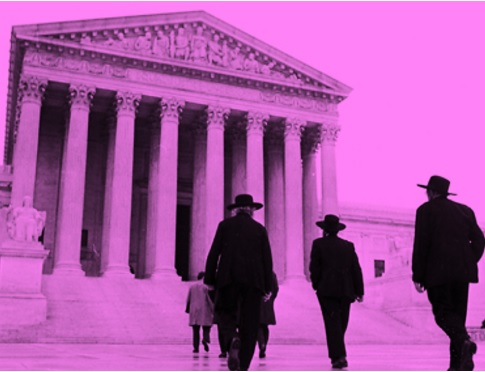
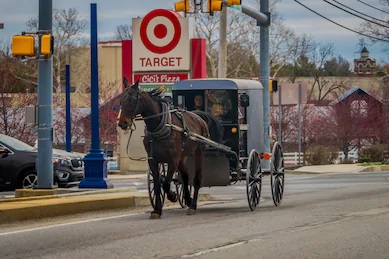
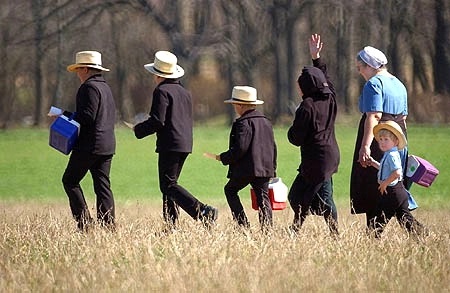
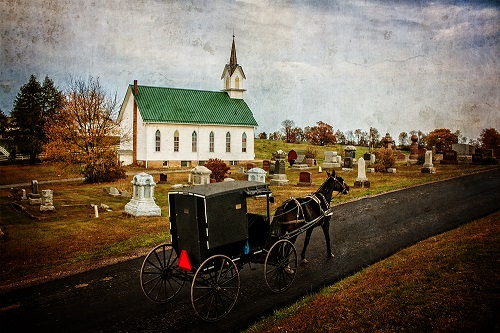
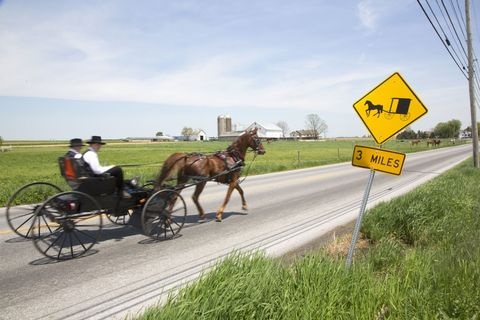
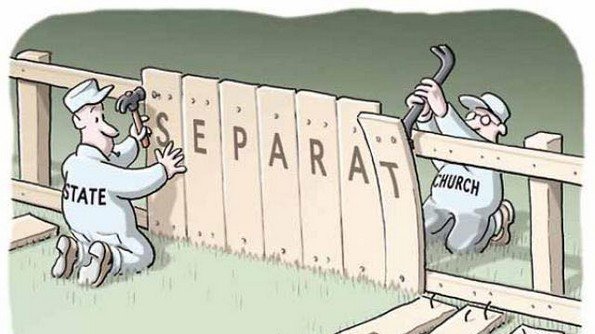
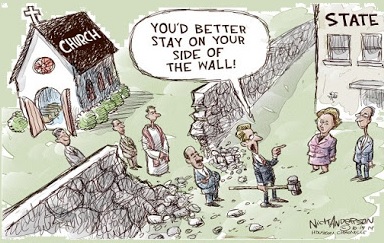 The Board of Education in Champaign, Illinois, allowed a local religious organization consisting of clergy and other volunteers to come into their public schools and teach religion classes during the school day. The organization, calling itself the Champaign Council on Religious Education, offered Protestant, Catholic, or Jewish options. The classes were “voluntary,” and any expenses were paid for by the Council, not the school district or parents.
The Board of Education in Champaign, Illinois, allowed a local religious organization consisting of clergy and other volunteers to come into their public schools and teach religion classes during the school day. The organization, calling itself the Champaign Council on Religious Education, offered Protestant, Catholic, or Jewish options. The classes were “voluntary,” and any expenses were paid for by the Council, not the school district or parents.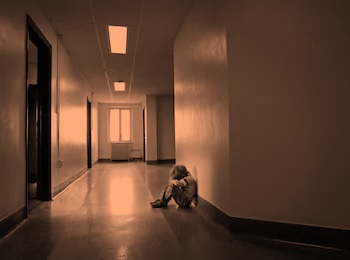 McCollum’s case reached the Supreme Court in 1947, the same year Everson v. Board of Education was decided. In Everson, the Court determined that state assistance to parents whose children rode public busses to school was fine, even though that assistance included families utilizing parochial schools. Everson was the first case of its kind to reach the Court and involved difficult questions about what the “wall of separation” meant in practice when applied to state and local government via the 14th Amendment. Plus, it hadn’t been decided at the time McCollum first began pursuing her case in the courts. It’s unlikely she or anyone else involved had even heard of it yet.
McCollum’s case reached the Supreme Court in 1947, the same year Everson v. Board of Education was decided. In Everson, the Court determined that state assistance to parents whose children rode public busses to school was fine, even though that assistance included families utilizing parochial schools. Everson was the first case of its kind to reach the Court and involved difficult questions about what the “wall of separation” meant in practice when applied to state and local government via the 14th Amendment. Plus, it hadn’t been decided at the time McCollum first began pursuing her case in the courts. It’s unlikely she or anyone else involved had even heard of it yet.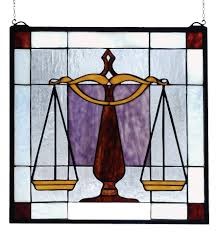 When McCollum’s case reached the Supreme Court, a supportive amicus curiae (“friend of the court”) brief was filed by none other than the Baptist Joint Committee for Religious Liberty. This group was in some ways the intellectual and spiritual descendants of those whacky Danbury Baptists who a century-and-a-half before had written to President Thomas Jefferson about the need for protection from the State. Jefferson’s response coined the phrase “a wall of separation,” which quickly became canon in interpreting the two church-state clauses of the First Amendment.
When McCollum’s case reached the Supreme Court, a supportive amicus curiae (“friend of the court”) brief was filed by none other than the Baptist Joint Committee for Religious Liberty. This group was in some ways the intellectual and spiritual descendants of those whacky Danbury Baptists who a century-and-a-half before had written to President Thomas Jefferson about the need for protection from the State. Jefferson’s response coined the phrase “a wall of separation,” which quickly became canon in interpreting the two church-state clauses of the First Amendment.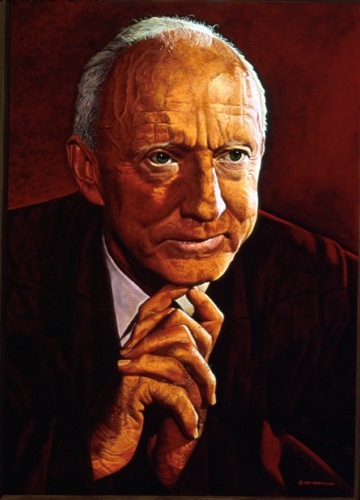 The Majority Opinion
The Majority Opinion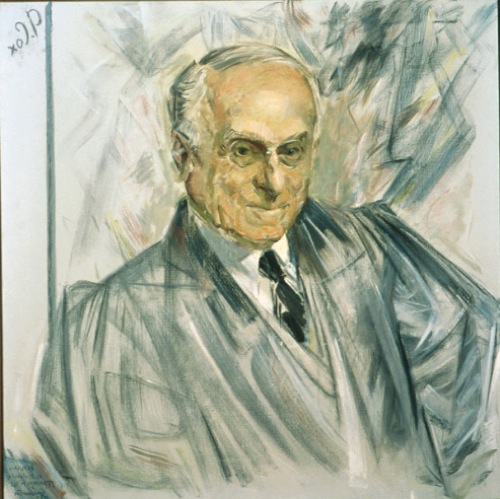 Frankfurter’s Concurrence
Frankfurter’s Concurrence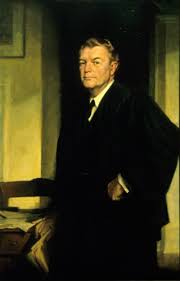 Jackson’s Concurrence
Jackson’s Concurrence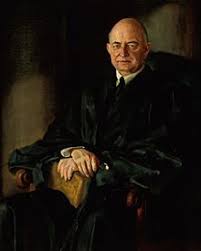 Reed’s Dissent
Reed’s Dissent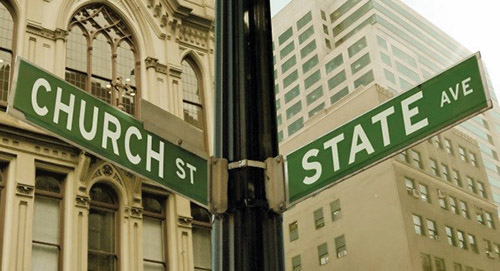 I’ve started putting together information and drafts for something which may or may not be titled “Have To” History: A Wall of Separation (Public School Edition). Call me wacky, but I find this stuff fascinating.
I’ve started putting together information and drafts for something which may or may not be titled “Have To” History: A Wall of Separation (Public School Edition). Call me wacky, but I find this stuff fascinating.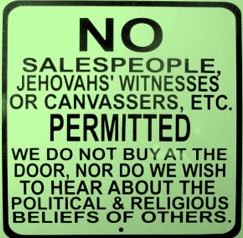 After the Supreme Court’s decision in Minersville School District v. Gobitis (1940), harassment and violence towards Jehovah’s Witnesses surged dramatically across the United States. Many felt validated and encouraged by the Court’s decision, which in their mind had essentially prioritized loyalty and being a good American over freedom of religion, speech, or association. It didn’t help that the U.S. entered World War II shortly thereafter, making patriotism and loyalty towards one’s nation and the flag representing it even more essential in the minds of many and any deviance not merely suspect, but dangerous.
After the Supreme Court’s decision in Minersville School District v. Gobitis (1940), harassment and violence towards Jehovah’s Witnesses surged dramatically across the United States. Many felt validated and encouraged by the Court’s decision, which in their mind had essentially prioritized loyalty and being a good American over freedom of religion, speech, or association. It didn’t help that the U.S. entered World War II shortly thereafter, making patriotism and loyalty towards one’s nation and the flag representing it even more essential in the minds of many and any deviance not merely suspect, but dangerous.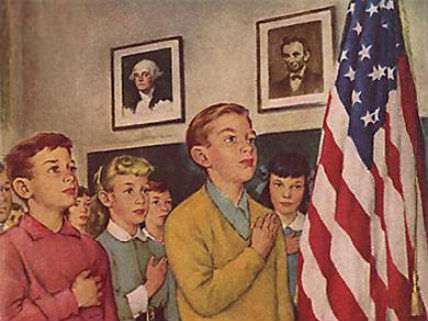 Perhaps not surprisingly, persecution only strengthened the resolve of the Jehovah’s Witnesses. Their kids still to have other gods before the Big One. It was a mere three years before almost the exact same case as Gobitis came before the High Court once again. This time, the results would be a tiny bit different.
Perhaps not surprisingly, persecution only strengthened the resolve of the Jehovah’s Witnesses. Their kids still to have other gods before the Big One. It was a mere three years before almost the exact same case as Gobitis came before the High Court once again. This time, the results would be a tiny bit different.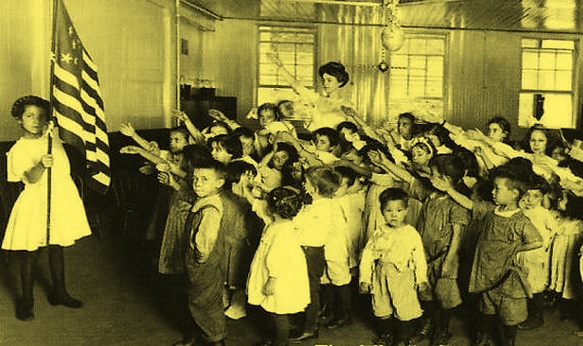 West Virginia and other states did allow some modification of the stiff-arm salute now associated with the Nazi Party. (Presumably, it was OK to behave like fascists as long as one used a slightly different arm motion while so doing.) They also tweaked the rules concerning expulsion. Children not saluting the flag and saying the Pledge would be sent home, after which parents would be prosecuted for not having them in school.
West Virginia and other states did allow some modification of the stiff-arm salute now associated with the Nazi Party. (Presumably, it was OK to behave like fascists as long as one used a slightly different arm motion while so doing.) They also tweaked the rules concerning expulsion. Children not saluting the flag and saying the Pledge would be sent home, after which parents would be prosecuted for not having them in school.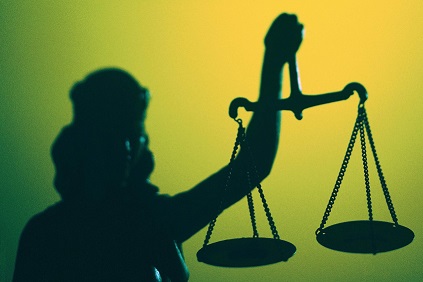 In a rather bold move, the three-judge court not only decided in favor of the Barnettes, but made no effort to justify their decision by pretending this case was in some way different than its predecessor. Instead, they simply explained their reasoning based on developments since Gobitis, along with their own interpretation of the law and the Bill of Rights. Taken together, it’s a written opinion as eloquent as anything coming from the Supremes in those days:
In a rather bold move, the three-judge court not only decided in favor of the Barnettes, but made no effort to justify their decision by pretending this case was in some way different than its predecessor. Instead, they simply explained their reasoning based on developments since Gobitis, along with their own interpretation of the law and the Bill of Rights. Taken together, it’s a written opinion as eloquent as anything coming from the Supremes in those days: The State appealed the case up the ladder (hence the reversal in the order of the names) and the Supreme Court was given an opportunity to try again. This time, they ruled 6 – 3 in favor of the Jehovah’s Witnesses. The majority focused less on religious freedom for Jehovah’s Witnesses and more on freedom of speech (or lack thereof) in general. It’s not just that children of certain faiths should be free to respectfully abstain from public recitations of mandatory patriotism, they argued – it was bigger than that. There are certain core liberties which should be protected for everyone, regardless of the specific belief system or point of view involved:
The State appealed the case up the ladder (hence the reversal in the order of the names) and the Supreme Court was given an opportunity to try again. This time, they ruled 6 – 3 in favor of the Jehovah’s Witnesses. The majority focused less on religious freedom for Jehovah’s Witnesses and more on freedom of speech (or lack thereof) in general. It’s not just that children of certain faiths should be free to respectfully abstain from public recitations of mandatory patriotism, they argued – it was bigger than that. There are certain core liberties which should be protected for everyone, regardless of the specific belief system or point of view involved: Barnette was a turning point for jurisprudence involving the freedoms enshrined in the Bill of Rights. Initially, the first ten Amendments were added to the new Constitution as limits on what the federal government could do or demand of individuals. While state constitutions might offer similar protections for speech, religion, etc., there was no national standard for such things until the first half of the 20th century, when the Court began utilizing the 14th Amendment (ratified just after the Civil War, in 1868) to apply the protections and ideals of the Bill of Rights to the relationship between citizens and state or local government as well.
Barnette was a turning point for jurisprudence involving the freedoms enshrined in the Bill of Rights. Initially, the first ten Amendments were added to the new Constitution as limits on what the federal government could do or demand of individuals. While state constitutions might offer similar protections for speech, religion, etc., there was no national standard for such things until the first half of the 20th century, when the Court began utilizing the 14th Amendment (ratified just after the Civil War, in 1868) to apply the protections and ideals of the Bill of Rights to the relationship between citizens and state or local government as well. The basic principle still holds – there are laws and expectations ever citizen must heed, regardless of belief system or personal creed. After Barnette, though, sincerely held religious convictions gained substantial ground in terms of what they could or couldn’t be used to justify, both in the world of public education and beyond. Also magnified was the idea that fundamental freedoms like those guaranteed in the Bill of Rights shouldn’t have to wait on legislatures or the next election to find protection – an approach which will be applied to full effect by the Warren Court of the 1950s and 1960s.
The basic principle still holds – there are laws and expectations ever citizen must heed, regardless of belief system or personal creed. After Barnette, though, sincerely held religious convictions gained substantial ground in terms of what they could or couldn’t be used to justify, both in the world of public education and beyond. Also magnified was the idea that fundamental freedoms like those guaranteed in the Bill of Rights shouldn’t have to wait on legislatures or the next election to find protection – an approach which will be applied to full effect by the Warren Court of the 1950s and 1960s. Several years ago, my wife and I moved to northern Indiana from Oklahoma and I started a job at a new school. Day One, first hour, I was about 30 seconds into introducing our opening activity when I was interrupted by announcements via school intercom. “Please stand for the Pledge of Allegiance…”
Several years ago, my wife and I moved to northern Indiana from Oklahoma and I started a job at a new school. Day One, first hour, I was about 30 seconds into introducing our opening activity when I was interrupted by announcements via school intercom. “Please stand for the Pledge of Allegiance…” I recently finished
I recently finished  In the waning years of the Great Depression, as Europe stumbled towards war, patriotism in the United States became mandatory in all but name. Many states passed laws requiring all public school students to salute the American Flag and say the Pledge of Allegiance each day, apparently assuming that nothing promotes heartfelt commitment like mandatory obeisance. If you’ve seen pictures from the era, you may notice that the standard salute looked different than it does today. Typically, it involved the right arm extended forward and upwards at a slight degree towards the flag as participants chanted in unison their devotion to the collective.
In the waning years of the Great Depression, as Europe stumbled towards war, patriotism in the United States became mandatory in all but name. Many states passed laws requiring all public school students to salute the American Flag and say the Pledge of Allegiance each day, apparently assuming that nothing promotes heartfelt commitment like mandatory obeisance. If you’ve seen pictures from the era, you may notice that the standard salute looked different than it does today. Typically, it involved the right arm extended forward and upwards at a slight degree towards the flag as participants chanted in unison their devotion to the collective. We like to imagine the Supreme Court as remaining safely beyond the pale of popular opinion or social forces, but they are at times quite human and may even read the news from time to time. The makeup of the Court evolves as well, and shortly after the Gobitis decision, it changed rather dramatically. Chief Justice Charles E. Hughes retired, as did Justice McReynolds. Justice Stone, author of the sole dissent in Gobitis, was promoted to Chief Justice, and Justices Robert Jackson and Wiley Rutledge joined the Court.
We like to imagine the Supreme Court as remaining safely beyond the pale of popular opinion or social forces, but they are at times quite human and may even read the news from time to time. The makeup of the Court evolves as well, and shortly after the Gobitis decision, it changed rather dramatically. Chief Justice Charles E. Hughes retired, as did Justice McReynolds. Justice Stone, author of the sole dissent in Gobitis, was promoted to Chief Justice, and Justices Robert Jackson and Wiley Rutledge joined the Court.